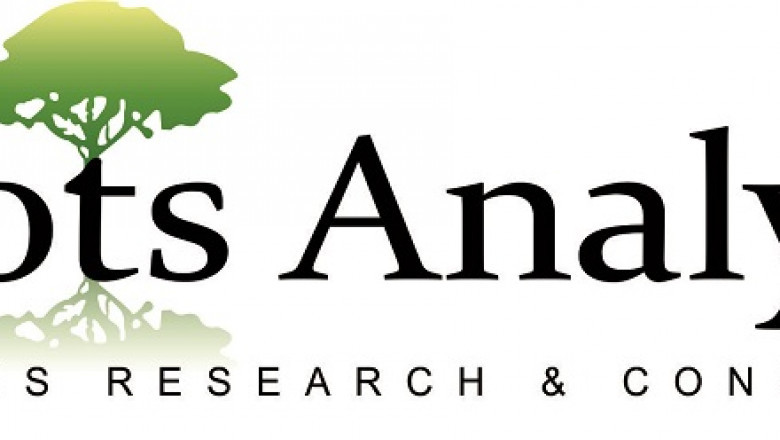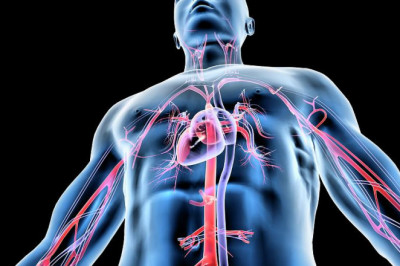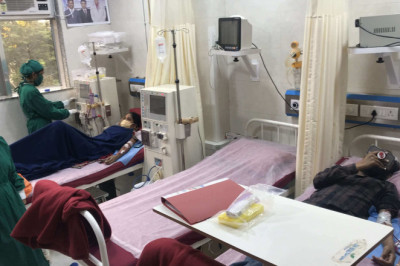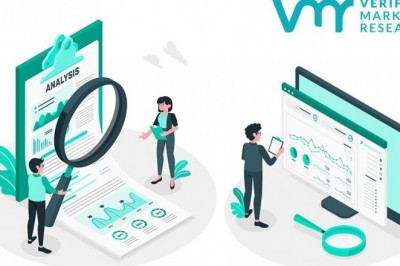views

The synthetic lethality-based drugs and targets market is projected to grow at an annualized rate of ~18%, till 2030
Roots Analysis has done a detailedstudy on “Synthetic Lethality-based Drugs andTargets Market, 2019-2030: Focus on DNA Repair (including PARP Inhibitors) andOther Novel Cellular Pathways” covering key aspects of theindustry’s evolution and identifying potential future growth opportunities.
To order this 485+ page report, which features 195+figures and 200+ tables, please visit https://www.rootsanalysis.com/reports/view_document/synthetic-lethality-based-drugs-and-targets-market-2019-2030-focus-on-/267.html
Key Market Insights
§ An analysis of recent activity on Twitter confirms therising interest in this domain as stakeholders attempt to harness thetherapeutic potential of synthetic lethality
§ About 75 drug candidates basedon synlet gene pairs are being evaluated for the treatment of various types ofcancers; presently, there are over 20 screening platforms enabling therapydevelopment efforts
§ The pipeline featuresboth small molecules and biologic drugs based on different synlet targets fortreating a variety of oncological and non-oncological indications
§ Innovation in thisdomain is evident across the plethora of scientific articles published inprestigious journals, highlighting key focus areas and prevalent / upcomingtrends
§ Over time, severalnon-profit organizations have extended financial support to aid researchefforts in this domain; the current focus appears to be on the identificationof novel synlet targets across different clinical conditions
§ Significant advances inresearch have led to the discovery of a wide array of synlet targets; overtime, substantial intellectual capital has been generated and validated byeminent scientists from renowned research institutes
§ To support innovation,several private and public investors have made substantial capital investments,totalling to approximately USD 5.1 billion, across 100 instances of funding
§ The personalizedapproach offered by companion diagnostics presents enormous opportunities fordrug developers to partner with diagnostic test providers to improve patient /subject selection in clinical trials
§ Future growth of themarket is likely to be driven by the success of clinical outcomes of late-stagemolecules; industry stakeholders are optimistic about the vast potential ofPARP inhibitors
§ In the mid to longterm, the anticipated market opportunity is likely to be well distributedacross advanced cancer indications, delivery routes and various global regions
For more information, please visit https://www.rootsanalysis.com/reports/view_document/synthetic-lethality-based-drugs-and-targets-market-2019-2030-focus-on-dna-repair-including-parp-inhibitors-and-other-novel-cellular-pathways/267.html
Tableof Contents
1. PREFACE
1.1. Scope of the Report
1.2. Research Methodology
1.3. Chapter Outlines
2. EXECUTIVE SUMMARY
3. INTRODUCTION TO DNA DAMAGEAND REPAIR SYSTEMS
3.1. Chapter Overview
3.2. Overview of DeoxyribonucleicAcid (DNA) Damage
3.3. DNA Damaging Agents
3.3.1. Endogenous DNA Damaging Agents
3.3.2. Exogenous DNA Damaging Agents
3.3.3. Other DNA Damaging Agents
3.4. DNA Damage Response System
3.4.1. Key Components of DNA RepairSystem
3.5. Types of DNA Repair Systems
3.5.1. Direct Repair
3.5.1.1. Photoreactivation
3.5.1.2. Alkyl Transferase Mediated DirectDNA Repair
3.5.1.3. AlkB Mediated Direct DNA Repair
3.5.1.4. DNA Ligase Mediated Direct DNARepair
3.5.2. Excision Repair
3.5.2.1. Base Excision Repair (BER)
3.5.2.1.1. BER Pathway: Key Enzymes
3.5.2.1.1.1. DNA Glycosylases
3.5.2.1.1.2. Apurinic / Apyrimidinic (AP)Endonucleases
3.5.2.1.1.3. Other Enzymes
3.5.2.1.2. Short-Patch Base Excision Repair
3.5.2.1.3. Long-Patch Base Excision Repair
3.5.2.2. Nucleotide Excision Repair (NER)
3.5.2.3. Mismatch Repair
3.5.3. Indirect Repair
3.5.3.1. Homologous Recombination Repair(HRR)
3.5.3.2. Non-Homologous End-Joining
3.6. Mutations in DNA Repair Genes
4. INTRODUCTION TO SYNTHETICLETHALITY
4.1. Chapter Overview
4.2. Concept of SyntheticLethality
4.2.1. Historical Evolution ofSynthetic Lethality
4.2.2. HRR and Synthetic Lethality
4.2.3. Other Synthetic Lethal GeneInteractions
4.2.4. Advantages of SyntheticLethality
4.2.5. Limitations of SyntheticLethality
4.3. Identification of SynletInteractions
4.3.1. Hypothesis-Driven Approach
4.3.2. Screening-Based Approaches
4.3.2.1. Chemical Library-Based ScreeningApproaches
4.3.2.1.1. Non-Annotated Libraries
4.3.2.1.2. Annotated Libraries
4.3.2.2. Genome-Wide Interference-BasedScreening Approaches
4.3.2.2.1. Ribonucleic Acid Interference (RNAi)Based Synlet Target Identification
4.3.2.2.2. Clustered Regularly Interspaced ShortPalindromic Repeats (CRISPR) Based Synlet Target Identification
4.3.3. In Silico Approaches
4.4. Prevalent Trends Related toSynthetic Lethality
4.4.1. Recent News on Google: EmergingFocus Areas
4.4.2. Google Trends Analysis:Historical Timeline
4.4.3. Google Trends Analysis:Geographical Activity
4.4.4. Google Trends Analysis: OtherKey Terms Related to Synthetic Lethality
4.5 Concluding Remarks
5. MARKET OVERVIEW
5.1. Chapter Overview
5.2. Synthetic Lethality-basedDrugs: Marketed and Development Pipeline
5.2.1. Analysis by Phase of Development
5.2.2. Analysis by Type of Molecule
5.2.3. Analysis by Type of Therapy
5.2.4. Analysis by Type of SynletTarget
5.2.5. Analysis by Therapeutic Area
5.2.6. Analysis by Target Indication
5.2.7. Analysis by Patient Segment
5.2.8. Analysis by Route ofAdministration
5.3. Synthetic Lethality-basedDrugs: List of Screening Platforms
5.4 SyntheticLethality-based Drugs: List of Drug Developers / Screening Platform Providers
5.4.1. Analysis by Year ofEstablishment
5.4.2. Analysis by Location ofHeadquarters
5.4.3. Analysis by Company Size
5.4.4. Analysis by Company Size andLocation of Headquarters
5.4.5. Leading Drug Developers
6. COMPANY PROFILES
6.1. Chapter Overview
6.2. Profiles of EstablishedPlayers
6.2.1. AbbVie
6.2.1.1. Company Overview
6.2.1.2. Synthetic Lethality-based Drug Portfolio
6.2.1.2.1. Veliparib (ABT-888)
6.2.1.3. Recent Developments and FutureOutlook
6.2.2. AstraZeneca
6.2.2.1. Company Overview
6.2.2.2. Synthetic Lethality-based DrugPortfolio
6.2.2.2.1. Olaparib (Lynparza®)
6.2.2.2.2. AZD6738
6.2.2.2.3. AZD1775
6.2.2.3. Recent Developments and FutureOutlook
6.2.3. BeiGene
6.2.3.1. Company Overview
6.2.3.2. Synthetic Lethality-based DrugPortfolio
6.2.3.2.1. Pamiparib (BGB-290)
6.2.3.3. Recent Developments and FutureOutlook
6.2.4. Clovis Oncology
6.2.4.1. Company Overview
6.2.4.2. Synthetic Lethality-based DrugPortfolio
6.2.4.2.1. Rucaparib (Rubraca®)
6.2.4.3. Recent Developments and FutureOutlook
6.2.5. GlaxoSmithKline
6.2.5.1. Company Overview
6.2.5.2. Synthetic Lethality-based Drug Portfolio
6.2.5.2.1. Niraparib (Zejula®)
6.2.5.3. Recent Developments and FutureOutlook
6.2.6. Pfizer
6.2.6.1. Company Overview
6.2.6.2. Synthetic Lethality-based DrugPortfolio
6.2.6.2.1. Talazoparib (TALZENNA®)
6.2.6.3. Recent Developments and Future Outlook
6.3. Profiles of Small andMid-Sized Players
6.3.1. AtlasMedx
6.3.2. Chordia Therapeutics
6.3.3. IDEAYA Biosciences
6.3.4. Mission Therapeutics
6.3.5. Repare Therapeutics
6.3.6. Sierra Oncology
6.3.7. SyntheX Labs
7. EMERGING TRENDS ON SOCIALMEDIA
7.1. Chapter Overview
7.2. Scope and Methodology
7.3. Synthetic Lethality: Trendson Twitter
7.3.1. Cumulative Year-Wise Activity
7.3.2. Historical Trends in Volume ofTweets
7.3.3. Evolutionary Trend Analysis
7.3.4. Trending Words / Phrases onTwitter
7.3.5. Most Prolific Contributors onTwitter
7.3.6. Most Popular Synlet Targets /Patient Mutations on Twitter
7.3.7. Most Popular Indications onTwitter
7.3.8. Heat Map Analysis: Distributionby Synlet Targets / Patient Mutations and Indications
7.4. Most Popular Tweets
7.5. Concluding Remarks
8. PUBLICATION ANALYSIS
8.1. Chapter Overview
8.2. Scope and Methodology
8.3. Synthetic Lethality: List ofRecent Publications, 2019
8.3.1. Analysis by Type of Publication
8.3.2. Analysis by Study Objective
8.4. Synthetic Lethality:Publication Analysis, 2017–2019
8.4.1. Analysis by Year of Publication
8.4.2. Emerging Focus Areas
8.4.3. Analysis by Synlet Targets /Patient Mutations
8.4.3.1. Most Popular Synlet Targets /Patient Mutations
8.4.3.2. Year-Wise Trend in Activity forPopular Synlet Targets / Patient Mutations
8.4.4. Analysis by Target Indications
8.4.4.1. Most Popular Target Indications
8.4.4.2. Year-Wise Trend in Activity forPopular Target Indications
8.4.5. Analysis by Key ResearchJournals
8.4.5.1. Key Journals Based on Number ofPublications
8.4.5.2. Analysis by Journal Impact Factor
8.4.5.3. Key Journals Based on JournalImpact Factor
8.4.6. Key Research Hubs
8.4.7. Most Popular Authors
8.4.8. Analysis of Publications withGrant Support
8.4.8.1. Most Popular Grant Bodies
8.4.8.2. Location of Grant Bodies
8.5. Publication BenchmarkAnalysis
9. ABSTRACT ANALYSIS
9.1. Chapter Overview
9.2. Scope and Methodology
9.3. Synthetic Lethality: List ofAmerican Society of Clinical Oncology Abstracts
9.3.1. Analysis by Year of Publication
9.3.2. Emerging Focus Areas
9.3.3. Most Popular Drugs
9.3.4. Most Popular Synlet Targets /Patient Mutations
9.3.5. Most Popular Target Indications
9.3.6. Most Popular Principal Authors
9.3.6.1. Analysis by Locations of PrincipalAuthors
9.3.6.2. Analysis by Type of Organization ofPrincipal Authors
9.3.6.3. Analysis by Active Organization
9.3.6.4. Analysis by Author Designation
9.3.6.5. Most Popular Authors
10. ACADEMIC GRANTS ANALYSIS
10.1. Chapter Overview
10.2. Scope and Methodology
10.3. Synthetic Lethality: List ofGrants Awarded by National Institutes of Health
10.3.1. Analysis by Year of Award
10.3.2. Analysis by Amount Awarded
10.3.3. Analysis by AdministeringInstitute Center
10.3.4. Analysis by Funding InstituteCenter
10.3.5. Analysis by Support Period
10.3.6. Analysis by Funding InstituteCenter and Support Period
10.3.7. Most Popular National Institute ofHealth (NIH) Funding Categorization
10.3.8. Analysis by Funding Mechanism
10.3.9. Analysis by Emerging Focus Areas
10.3.10. Most Popular Synlet Targets /Patient Mutations
10.3.11. Most Popular Target Indications
10.3.12. Analysis by Type of Grant Application
10.3.13. Most Popular NIH Departments
10.3.14. Analysis by Study Section
10.3.15. Analysis by Type of RecipientOrganization
10.3.16. Most Popular Recipient Organization
10.3.17. Most Popular Recipient Organizationand NIH Spending Sectors
10.3.18. Analysis by Grant Activity
10.3.19. Most Prominent Program Officers
10.3.20. Regional Distribution of RecipientOrganization
10.4. Grant Attractiveness Analysis
11. FUNDING AND INVESTMENTANALYSIS
11.1. Chapter Overview
11.2. Types of Funding
11.3. Synthetic Lethality: List ofFunding and Investments
11.3.1. Analysis by Number of Instances
11.3.2. Analysis by Amount Invested
11.3.3. Analysis by Type of Funding
11.3.4. Analysis by Type of Company
11.3.5. Analysis by Purpose of Funding
11.3.6. Analysis by Type of Molecule
11.3.7. Analysis by Synlet Target
11.3.8. Analysis by Therapeutic Area
11.3.9. Analysis by Target Indication
11.3.10. Analysis by Geography
11.3.11. Most Active Players
11.3.12. Most Active Investors
11.4. Concluding Remarks
12. TARGET BENCHMARK ANALYSIS
12.1. Chapter Overview
12.2. Scope and Methodology
12.3. Target Benchmark Analysis
12.3.1. Clinically Validated SynletTargets
12.3.2. Preclinically Validated SynletTargets
12.3.3. Early Stage Research ValidatedSynlet Targets
12.4. Initiatives of BigPharmaceutical Players
12.5. Concluding Remarks
13. ROLE OF COMPANIONDIAGNOSTICS IN SYNTHETIC LETHALITY
13.1. Chapter Overview
13.2. Concept of CompanionDiagnostics
13.3. Development of CompanionDiagnostics
13.3.1. Co-development / ParallelDevelopment Approach
13.3.2. Development of CompanionDiagnostics Post Drug Approval
13.3.3. Developmentof already Approved Companion Diagnostics for New Drugs / Disease Indications
13.4. Advantages of CompanionDiagnostics
13.5. Applications of CompanionDiagnostics in Synthetic Lethality
13.6. Companion Diagnostics: List ofAvailable / Under Development Tests
13.6.1. Analysis by Synlet Target
13.6.2. Analysis by Type of Biomarker
13.6.3. Analysis by Type of Biomarker andTechnology
13.6.4. Analysis by Target Indication
13.6.5. Analysis by Developer and SynletTarget
13.6.6. Most Prominent Developers
13.7. Case-in-Point:Companion Diagnostics for Commercially Available Poly-ADP Ribose Polymerase(PARP) Inhibitors
13.7.1. Companion Diagnostics Test forNiraparib
13.7.1.1. Product Overview
13.7.1.2. Working Process
13.7.1.3. Collaborations
13.7.2. Companion Diagnostics Test forOlaparib
13.7.2.1. Product Overview
13.7.2.2. Working Process
13.7.2.3. Collaborations
13.7.3. Companion Diagnostics Test forRucaparib
13.7.3.1. Product Overview
13.7.3.2. Collaborations
13.7.4. Companion Diagnostics Test forTalazoparib
13.7.4.1. Product Overview
13.7.4.2. Collaborations
13.8. Future Perspective
14. MARKET FORECAST
14.1. Chapter Overview
14.2. Scope and Limitations
14.3. Forecast Methodology and KeyAssumptions
14.4. Overall Synthetic Lethality-basedDrugs Market, 2019-2030
14.4.1. SyntheticLethality-based Drugs Market: Distribution by Type of Molecule, 2019 and 2030
14.4.1.1. Synthetic Lethality-based DrugsMarket for Small Molecule, 2019-2030
14.4.1.2. Synthetic Lethality-based DrugsMarket for Biologic, 2019-2030
14.4.2. SyntheticLethality-based Drugs Market: Distribution by Synlet Target, 2019 and 2030
14.4.2.1. Synthetic Lethality-based DrugsMarket for APE1 / REF-1, 2019-2030
14.4.2.2. Synthetic Lethality-based DrugsMarket for CHK1, 2019-2030
14.4.2.3. Synthetic Lethality-based DrugsMarket for GLS1, 2019-2030
14.4.2.4. Synthetic Lethality-based DrugsMarket for PARP, 2019-2030
14.4.2.5. Synthetic Lethality-based DrugsMarket for Polθ, 2019-2030
14.4.2.6. Synthetic Lethality-based DrugsMarket for WEE1, 2019-2030
14.4.3. SyntheticLethality-based Drugs Market: Distribution by Target Indication, 2019 and 2030
14.4.3.1. Synthetic Lethality-based DrugsMarket for Breast Cancer, 2019-2030
14.4.3.2. Synthetic Lethality-based DrugsMarket for Cervical / Anogenital Cancer, 2019-2030
14.4.3.3. Synthetic Lethality-based DrugsMarket for Diabetic Macular Edema, 2019-2030
14.4.3.4. Synthetic Lethality-based DrugsMarket for Gastric Cancer, 2019-2030
14.4.3.5. Synthetic Lethality-based DrugsMarket for Lung Cancer, 2019-2030
14.4.3.5. Synthetic Lethality-based DrugsMarket for Ovarian Cancer, 2019-2030
14.4.3.7. Synthetic Lethality-based DrugsMarket for Renal Cell Cancer, 2019-2030
14.4.4. SyntheticLethality-based Drugs Market: Distribution by Route of Administration, 2019 and 2030
14.4.4.1. Synthetic Lethality-based DrugsMarket for Oral Therapies, 2019-2030
14.4.4.2. Synthetic Lethality-based DrugsMarket for Intravenous Therapies, 2019-2030
14.4.5. SyntheticLethality-based Drugs Market: Distribution by Geography, 2019 and 2030
14.4.5.1. Synthetic Lethality-based DrugsMarket in the US, 2019-2030
14.4.5.2. Synthetic Lethality-based DrugsMarket in France, 2019-2030
14.4.5.3. Synthetic Lethality-based DrugsMarket in Germany, 2019-2030
14.4.5.4. Synthetic Lethality-based DrugsMarket in Italy, 2019-2030
14.4.5.5. Synthetic Lethality-based DrugsMarket in Spain, 2019-2030
14.4.5.6. Synthetic Lethality-based DrugsMarket in the UK, 2019-2030
14.4.5.8. Synthetic Lethality-based DrugsMarket in Australia, 2019-2030
14.4.5.7. Synthetic Lethality-based DrugsMarket in China, 2019-2030
14.4.5.8. Synthetic Lethality-based DrugsMarket in Japan, 2019-2030
14.4.6. Product-wise Sales Forecast
14.4.6.1 Niraparib (GlaxoSmithKline)
14.4.6.1.1. Target Patient Population
14.4.6.1.2. Sales Forecast (USD Million)
14.4.6.1.3. Net Present Value (USD Million)
14.4.6.1.4. Value Creation Analysis
14.4.6.2. Olaparib (AstraZeneca)
14.4.6.2.1. Target Patient Population
14.4.6.2.2. Sales Forecast (USD Million)
14.4.6.2.3. Net Present Value (USD Million)
14.4.6.2.4. Value Creation Analysis
14.4.6.3. Rucaparib (Clovis Oncology)
14.4.6.3.1. Target Patient Population
14.4.6.3.2. Sales Forecast (USD Million)
14.4.6.3.3. Net Present Value (USD Million)
14.4.6.3.4. Value Creation Analysis
14.4.6.4. Talazoparib (Pfizer)
14.4.6.4.1. Target Patient Population
14.4.6.4.2. Sales Forecast (USD Million)
14.4.6.4.3. Net Present Value (USD Million)
14.4.6.4.4. Value Creation Analysis
14.4.6.5. Pamiparib (BeiGene)
14.4.6.5.1. Target Patient Population
14.4.6.5.2. Sales Forecast (USD Million)
14.4.6.5.3. Net Present Value (USD Million)
14.4.6.5.4. Value Creation Analysis
14.4.6.6. Veliparib (AbbVie)
14.4.6.6.1. Target Patient Population
14.4.6.6.2. Sales Forecast (USD Million)
14.4.6.6.3. Net Present Value (USD Million)
14.4.6.6.4. Value Creation Analysis
14.4.6.7. Adavosertib (AstraZeneca)
14.4.6.7.1. Target Patient Population
14.4.6.7.2. Sales Forecast (USD Million)
14.4.6.7.3. Net Present Value (USD Million)
14.4.6.7.4. Value Creation Analysis
14.4.6.8. APX3330 (Apexian Pharmaceuticals)
14.4.6.8.1. Target Patient Population
14.4.6.8.2. Sales Forecast (USD Million)
14.4.6.8.3. Net Present Value (USD Million)
14.4.6.8.4. Value Creation Analysis
14.4.6.9. CX-5461 (Senhwa Biosciences)
14.4.6.9.1. Target Patient Population
14.4.6.9.2. Sales Forecast (USD Million)
14.4.6.9.3. Net Present Value (USD Million)
14.4.6.9.4. Value Creation Analysis
14.4.6.10. SRA737-01 (Sierra Oncology)
14.4.6.10.1. Target Patient Population
14.4.6.10.2. Sales Forecast (USD Million)
14.4.6.10.3. Net Present Value (USD Million)
14.4.6.10.4. Value Creation Analysis
14.4.6.11. SRA737-02 (Sierra Oncology)
14.4.6.11.1. Target Patient Population
14.4.6.11.2. Sales Forecast (USD Million)
14.4.6.11.3. Net Present Value (USD Million)
14.4.6.11.4. Value Creation Analysis
14.4.6.12. Telaglenastat (Calithera Biosciences)
14.4.6.12.1. Target Patient Population
14.4.6.12.2. Sales Forecast (USD Million)
14.4.6.12.3. Net Present Value (USD Million)
14.4.6.12.4. Value Creation Analysis
14.4.7. Concluding Remarks
15. CONCLUDING REMARKS
16. EXECUTIVE INSIGHTS
16.1. Chapter Overview
16.2. Artios Pharma
16.2.1. Company / Organization Snapshot
16.2.2. Interview Transcript: SimonBoulton, Vice President, Science Strategy
16.3. IMPACT Therapeutics
16.3.1. Company / Organization Snapshot
16.3.2. Interview Transcript: Yi Xu,Associate Director
16.4. Harvard Medical School
16.4.1. Company / Organization Snapshot
16.4.2. Interview Transcript: NorbertPerrimon, Professor, Department of Genetics
16.5. Panjab University
16.5.1. Company / Organization Snapshot
16.5.2. Interview Transcript: VivekDharwal, Professor, Department of Biochemistry
16.6. UbiQ
16.6.1. Company / Organization Snapshot
16.6.2. Interview Transcript: AlfredNijkerk, Chief Executive Officer
17. APPENDIX 1: TABULATED DATA
18. APPENDIX 2: LIST OFCOMPANIES AND ORGANIZATIONS
Contact Details
Gaurav Chaudhary
+1 (415) 800 3415












